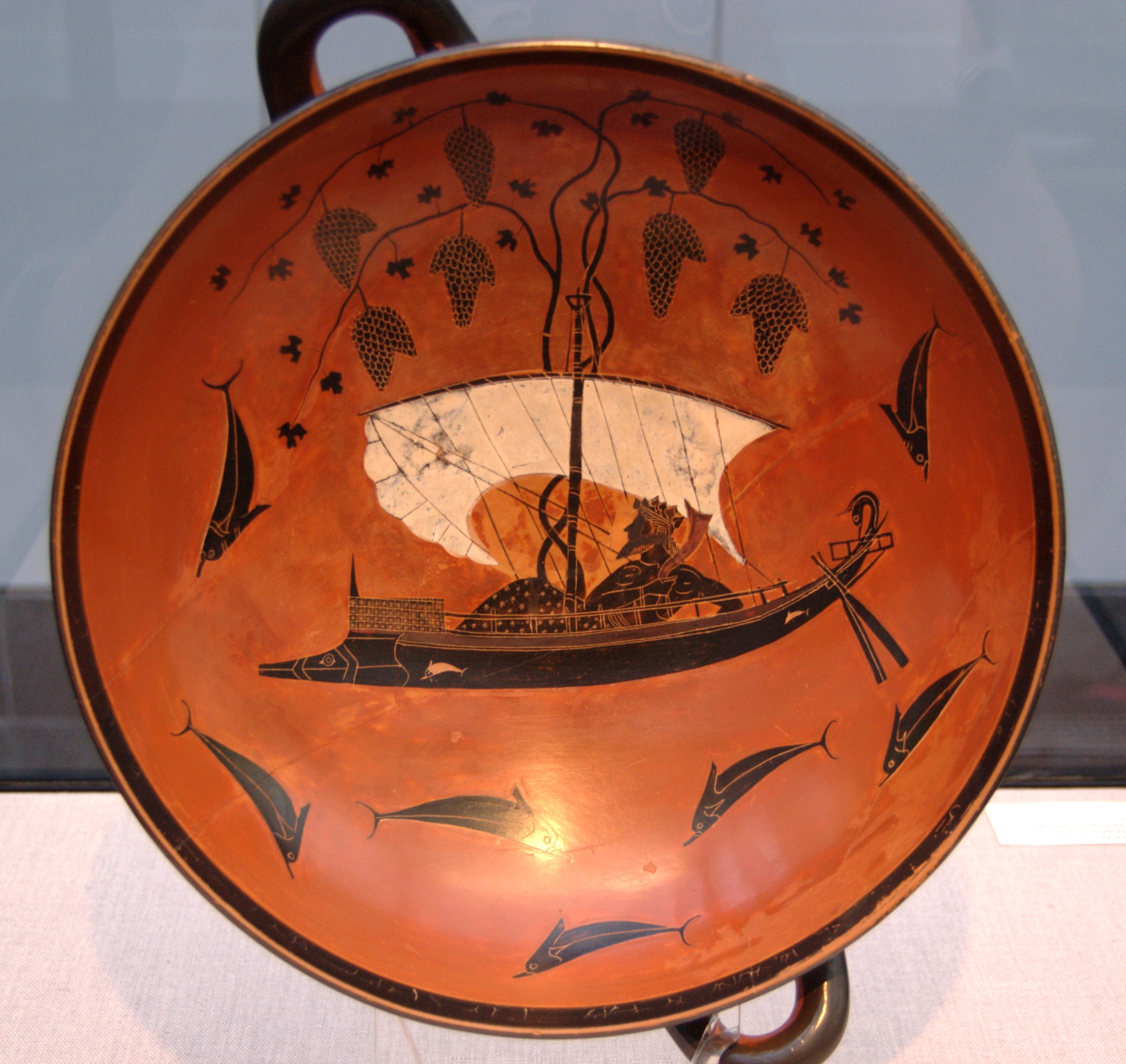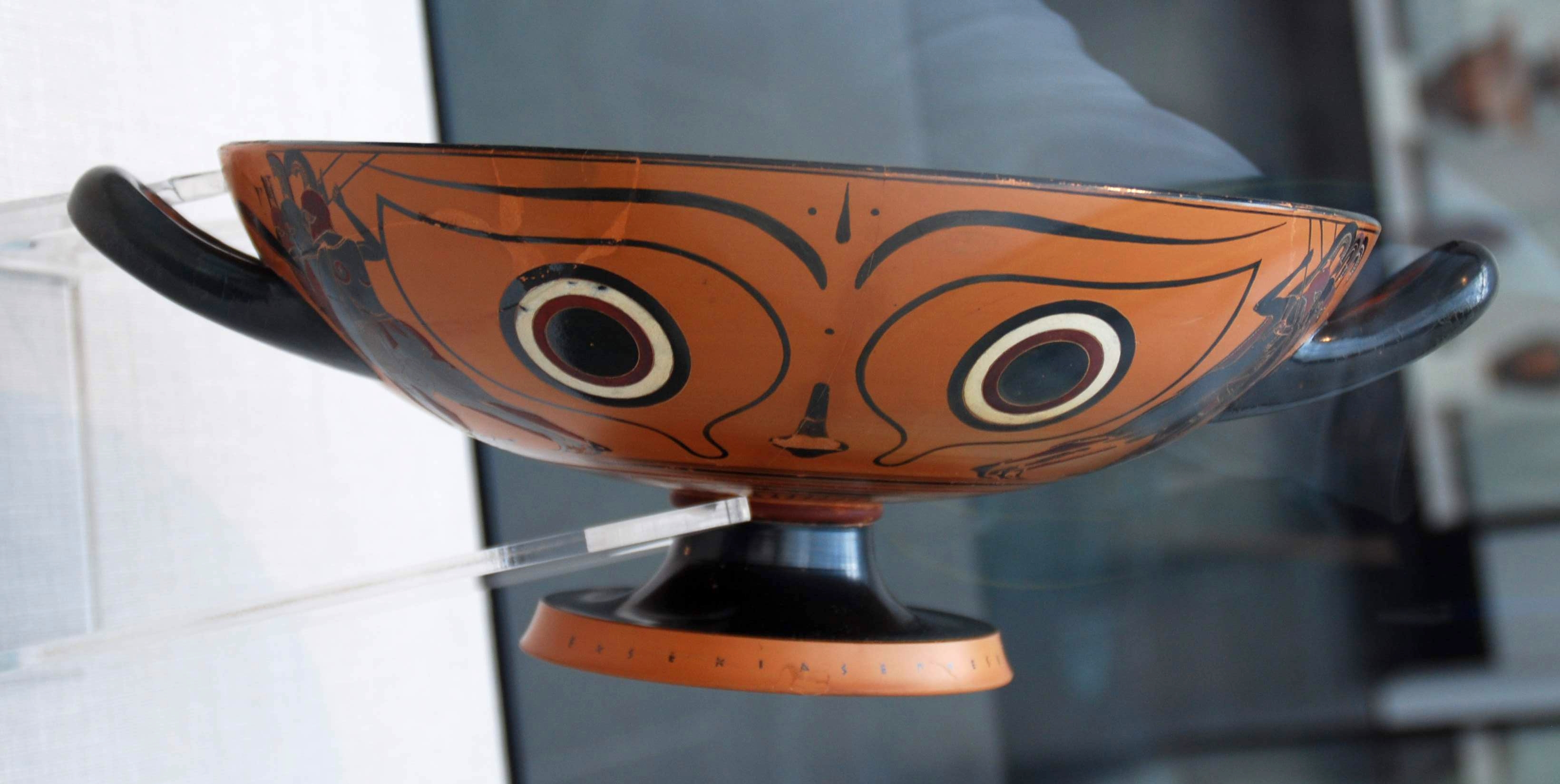Dionysus cup on:
[Wikipedia]
[Google]
[Amazon]
 The Dionysus Cup is the modern name for one of the best known works of ancient Greek vase painting, a '' kylix'' (drinking cup) dating to 540–530 BC. It is one of the masterpieces of the Attic
The Dionysus Cup is the modern name for one of the best known works of ancient Greek vase painting, a '' kylix'' (drinking cup) dating to 540–530 BC. It is one of the masterpieces of the Attic
 The cup is 13.6 cm high and has a diameter of 30.5 cm. It is complete and composed of only a few large sherds. The inside image, the tondo, takes up almost the entire interior of the cup. In the centre, a sailing ship is depicted, travelling from right to left. The prow of the ship is decorated like an animal's head, while the rudder is clearly discernable at the rear. Within the ship is a well over life sized figure, the god
The cup is 13.6 cm high and has a diameter of 30.5 cm. It is complete and composed of only a few large sherds. The inside image, the tondo, takes up almost the entire interior of the cup. In the centre, a sailing ship is depicted, travelling from right to left. The prow of the ship is decorated like an animal's head, while the rudder is clearly discernable at the rear. Within the ship is a well over life sized figure, the god
 Two meanings have been suggested for the interior image. Most common is the suggestion that is a reference to the seventh
Two meanings have been suggested for the interior image. Most common is the suggestion that is a reference to the seventh
Attic Black-figue Eye cup of Exekias (München, Staatliche Antikensammlung)
in the archaeological database Arachne {{Greek drinking cups Individual ancient Greek vases Staatliche Antikensammlungen Dionysus in art 6th-century BC works Archaeological discoveries in Italy 1841 archaeological discoveries
 The Dionysus Cup is the modern name for one of the best known works of ancient Greek vase painting, a '' kylix'' (drinking cup) dating to 540–530 BC. It is one of the masterpieces of the Attic
The Dionysus Cup is the modern name for one of the best known works of ancient Greek vase painting, a '' kylix'' (drinking cup) dating to 540–530 BC. It is one of the masterpieces of the Attic black-figure
Black-figure pottery painting, also known as the black-figure style or black-figure ceramic ( grc, , }), is one of the styles of painting on antique Greek vases. It was especially common between the 7th and 5th centuries BCE, although there are ...
potter Exekias
Exekias ( grc, Ἐξηκίας, ''Exēkías'') was an ancient Greek vase painter and potter who was active in Athens between roughly 545 BC and 530 BC. Exekias worked mainly in the black-figure technique, which involved the painting of scen ...
and one of the most significant works in the Staatliche Antikensammlungen in Munich
Munich ( ; german: München ; bar, Minga ) is the capital and most populous city of the German state of Bavaria. With a population of 1,558,395 inhabitants as of 31 July 2020, it is the third-largest city in Germany, after Berlin and Ha ...
.
Description
Dionysus
In ancient Greek religion and myth, Dionysus (; grc, Διόνυσος ) is the god of the grape-harvest, winemaking, orchards and fruit, vegetation, fertility, insanity, ritual madness, religious ecstasy, festivity, and theatre. The Roma ...
. The sail, unlike the rest of the image, is painted white, a common stylistic element in the black figure style. Vine
A vine (Latin ''vīnea'' "grapevine", "vineyard", from ''vīnum'' "wine") is any plant with a growth habit of trailing or scandent (that is, climbing) stems, lianas or runners. The word ''vine'' can also refer to such stems or runners themsel ...
s grow from the mast, with three large clusters of grapes on the right and four on the left. Dolphins swim below the ship—two towards the right, three towards the left—and a further dolphin is found on the right and the left hand sides of it. Although this is not realistic perspective, it could indicate that the dolphins are swimming around the ship. Like the vine, dolphins are symbols of Dionysos. In addition to this broad outline of the image, there are many detailed features. Two small dolphins are incised on the side of the ship. The long-haired, bearded god wears an ivy
''Hedera'', commonly called ivy (plural ivies), is a genus of 12–15 species of evergreen climbing or ground-creeping woody plants in the family Araliaceae, native to western, central and southern Europe, Macaronesia, northwestern Africa and ...
crown and holds a cornucopia
In classical antiquity, the cornucopia (), from Latin ''cornu'' (horn) and ''copia'' (abundance), also called the horn of plenty, was a symbol of abundance and nourishment, commonly a large horn-shaped container overflowing with produce, flowers ...
in his hand. His tunic bears a fine pattern. On the outside, around each of the handles, six warriors stand over a corpse. The space between the handles is decorated with a stylised face with large eyes and a small nose.
Context
 Two meanings have been suggested for the interior image. Most common is the suggestion that is a reference to the seventh
Two meanings have been suggested for the interior image. Most common is the suggestion that is a reference to the seventh Homeric Hymn
The ''Homeric Hymns'' () are a collection of thirty-three anonymous ancient Greek hymns celebrating individual gods. The hymns are "Homeric" in the sense that they employ the same epic meter—dactylic hexameter—as the ''Iliad'' and ''Odyssey'', ...
, in which it is explained how Dionysus was kidnapped by Etruscan __NOTOC__
Etruscan may refer to:
Ancient civilization
*The Etruscan language, an extinct language in ancient Italy
*Something derived from or related to the Etruscan civilization
**Etruscan architecture
**Etruscan art
**Etruscan cities
** Etrusca ...
pirates, who were unaware of his identity. The god confuses their thoughts and causes them to jump into the water, where they transform into dolphins. A second possibility is that the arrival of Dionysus at the Athenian Anthesteria is depicted. The images around the handles probably depict the battles for the corpses of Patroclus and Achilles
In Greek mythology, Achilles ( ) or Achilleus ( grc-gre, Ἀχιλλεύς) was a hero of the Trojan War, the greatest of all the Greek warriors, and the central character of Homer's '' Iliad''. He was the son of the Nereid Thetis and Pele ...
, with the naked corpse being Patroclus.
Innovation
The cup shows numerous technical innovations. As a potter, Exekias took older forms and reshaped them into a completely new one. This form, the so-called ''Cup type A'' with a thicker foot, a ring around the stem, and a deep, broad bowl, would quickly become the dominant form. The "eye-cup
Eye-cup is the term describing a specific cup type in ancient Greek pottery, distinguished by pairs of eyes painted on the external surface.
Description
Classified as '' kylikes'' in terms of shape, eye-cups were especially widespread in Ath ...
" motif was originally introduced by Exekias, possibly with this piece. Later on the nose in between the eyes grew rarer. The decoration around the handles was similarly new, but unlike the other innovations it did not catch on. Neither did the tondo nearly completely filling the inside of the cup, which was notably imitated later on by the Penthesilea Painter
The Penthesilea Painter (active between 470 and 450 BC at Athens) was a Greek vase painter of the Attic red-figure style. His true name is unknown. His conventional name is derived from his name vase, "bowl 2688" in Munich, the inside of which ...
, but is otherwise rather uncommon. Hitherto it had been common in general for the interior of a cup to be decorated with a small tondo depicting a gorgoneion
In Ancient Greece, the Gorgoneion ( Greek: Γοργόνειον) was a special apotropaic amulet showing the Gorgon head, used by the Olympian deities Athena and Zeus: both are said to have worn the gorgoneion as a protective pendant,. and o ...
. Also new, but only employed experimentally for a few years and then only rarely was the technique of Intentional Red
Intentions are mental states in which the agent commits themselves to a course of action. Having the plan to visit the zoo tomorrow is an example of an intention. The action plan is the ''content'' of the intention while the commitment is the ''a ...
, in which the background was made an intense, dark red clay. For this too, the cup is the earliest example. Inside of the cup, the decoration has no horizon line or specific orientation other than the ship and the grapes.
History
It is clear that Exekias was the potter, since he signed the foot with an inscription reading EΞΣΕΚΙΑΣ ΕΠΟΕΣΕ ("Exsekias made this"). The attribution of the painting to him derives from stylistic comparisons. Although the internal chronology of Exekias' works is still not fully understood, the cup is generally placed among his later works. The exact date varies between 540 and 530 BC. The cup was found duringLucien Bonaparte
Lucien Bonaparte, 1st Prince of Canino and Musignano (born Luciano Buonaparte; 21 May 1775 – 29 June 1840), was French politician and diplomat of the French Revolution and the Consulate. He served as Minister of the Interior from 1799 to 1800 ...
's excavations at Vulci
Vulci or Volci ( Etruscan: ''Velch'' or ''Velx'', depending on the romanization used) was a rich Etruscan city in what is now northern Lazio, central Italy.
As George Dennis wrote, "Vulci is a city whose very name... was scarcely remembered, b ...
and acquired for Ludwig I of Bavaria
en, Louis Charles Augustus
, image = Joseph Karl Stieler - King Ludwig I in his Coronation Robes - WGA21796.jpg
, caption = Portrait by Joseph Stieler, 1825
, succession=King of Bavaria
, reign =
, coronation ...
in 1841.
References
Bibliography
*John Beazley
Sir John Davidson Beazley, (; 13 September 1885 – 6 May 1970) was a British classical archaeologist and art historian, known for his classification of Attic vases by artistic style. He was Professor of Classical Archaeology and Art at the Un ...
. ''Attic Black-figure Vase-painters.'' Clarendon Press, Oxford 1956, p. 146 No. 21.
* John Boardman. ''Schwarzfigurige Vasen aus Athen. Ein Handbuch.'' Zabern, Mainz 1977, , p. 64.
* Matthias Steinhart Matthias Steinhart (born 17 April 1966 in Freiburg im Breisgau) is a German Classical archaeologist.
Life and work
After attending the humanistic Scheffel-Gymnasium in Lahr, Matthias Steinhart studied classical archaeology, Greek philology, and ...
. "Exekias" in '' Künstlerlexikon der Antike.'' Vol. 1. Saur, München, Leipzig 2001, pp. 249–252.
* Thomas Mannack
Thomas Mannack (born in 1958) is a German classical archaeologist.
Mannack obtained his Doctorate in 1992 with at the University of Kiel. The thema of his dissertation was ''Beazleys spätere und späteste Manieristen''. He is a specialist in ...
. ''Griechische Vasenmalerei. Eine Einführung.'' Theiss, Stuttgart 2002, , p. 121.
* Berthold Fellmann. ''München, Antikensammlungen, ehemals Museum antiker Kleinkunst.'' Vol. 13: ''Attische schwarzfigurige Augenschalen'' (= '' Corpus Vasorum Antiquorum Deutschland.'' Vol. 77). C. H. Beck, München 2004, , pp. 14–19 tbl. 1–4.
External links
Attic Black-figue Eye cup of Exekias (München, Staatliche Antikensammlung)
in the archaeological database Arachne {{Greek drinking cups Individual ancient Greek vases Staatliche Antikensammlungen Dionysus in art 6th-century BC works Archaeological discoveries in Italy 1841 archaeological discoveries